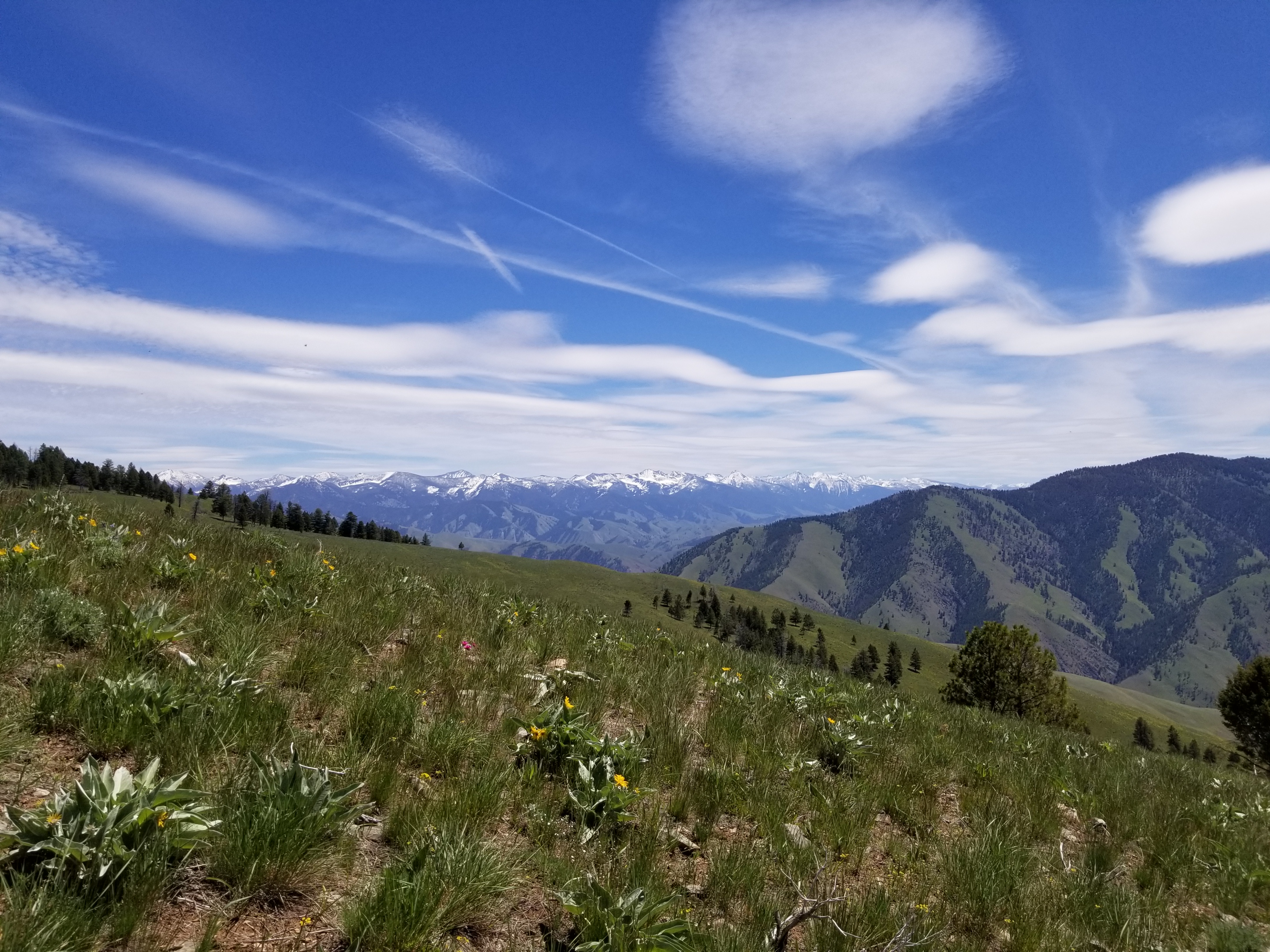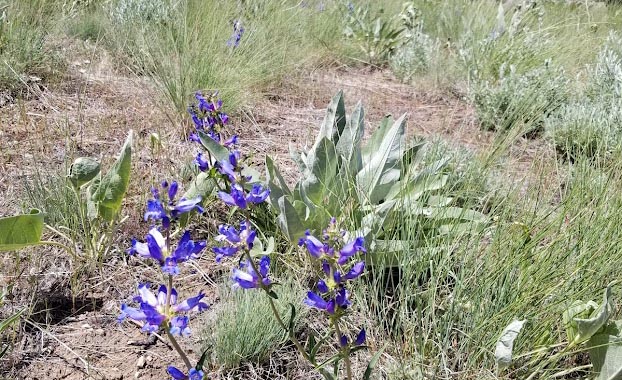Protecting Big Game Habitats in Idaho

Resilient wildlife populations require a resilient habitat. Treating and protecting the habitats of big game like mule deer, elk and bighorn sheep in the intermountain states is happening thanks to a collaborative effort among multiple local, state and national agencies. The work is worth it: Reducing cheatgrass is allowing native plants to thrive, reducing the risk of wildfires and bringing big game back to the area.
Idaho’s Salmon River Valley, like areas in many of our country’s intermountain states, relies heavily on tourism to support its economy. Recreation and hunting are as important on this multi-use land as ranching, and everyone in the area is positively affected when these parts of the economy succeed together. The impact of invasive weeds on the feeding sources for big game animals can hurt the tourism economy, but a multi-agency team of experts is working together to ensure that everyone — tourists, ranchers, residents and animals — have a healthy environment to share. Representatives of the Bureau of Land Management (BLM), Natural Resources Conservation Service (NRCS), the Mule Deer Foundation (MDF) and Idaho Fish and Game (IDFG) are leading the effort.
The BLM manages the largest wilderness area in the 48 contiguous states, approximately 800,000 acres of landscape that is home to wild game including elk, deer, mountain lions, wolves and black bears. It’s also a robust livestock and grazing area. Recreation seekers come for backpacking, camping, hunting and fishing for steelhead trout, salmon and bull trout, or to observe native plant species like whitebark pine.
“When you have a tourist-based economy, if you don’t have the right components in the ecosystem, then you won’t have the products the community needs to thrive,” said Jared Meyers, Weed Specialist, Invasive Species for the BLM Challis Field Office. “For example, we have hunters that come in because they want to shoot a big buck, but if those animals don’t have the right forage, they aren’t here. And then hunters don’t come in and support the local economy.”
All animals, whether grazed by ranchers, prized by hunters or appreciated by tourists, benefit from intact landscapes. “What’s good for wildlife is good for grazing lands,” said Jessie Shallow, Partnership Wildlife Biologist for the Mule Deer Foundation and Idaho Fish and Game. She evaluates the landscape from multiple points of view as a shared resource between multiple agencies.
The biggest problem that Shallow and her colleagues see in the area is cheatgrass. Rosana Rieth, Conservation Team Lead for the Natural Resources Conservation Service, said, “Cheatgrass doesn’t have the long-term forage quality that our native species exhibit.” She likens animals eating it to humans eating doughnuts.

View of a healthy landscape in the Salmon-Challis National Forest. Bunchgrass and balsam root are seen growing, with no cheatgrass present between plants.
She says that when cheatgrass infiltrates a landscape, it changes the animals that are around, too. “You lose the animals that rely on [beneficial forage].” Rieth added. “That can include grazing livestock, and then the ranchers’ livelihoods are affected.”
Animals like bighorn sheep rely on native sagebrush landscapes for their diversity of forage to graze, but cheatgrass can drive sagebrush and other preferred forage out. When it does, you can lose small game in the area as well, such as pygmy rabbits, sage grouse and more. And fewer animals means the loss of biodiversity.
But cheatgrass and other invasive weeds bring additional risks to the landscape. Cheatgrass provides a two-fold issue with wildfires. First, invasive weeds and cheatgrass provide more fuel for wildfires. And after a wildfire has come through, the landscape is primed for even more cheatgrass to come in.
“Wildfires are the number-one thing on my mind,” said Shallow. “At some point, there will be a fire almost everywhere we are working, and if we haven’t gone in ahead of time and removed that cheatgrass, then the fire makes a perfect bed for it to come in.” But if the cheatgrass has been removed, it reduces the fuel available to feed a potential fire.
“Cheatgrass burns hotter and more often,” said Rieth. “Sagebrush won’t burn as often or as hot, but if you lose the sagebrush, it may never come back on its own.”
“Attacking weeds and invasive grass is like winning a war. You need to attack at every angle,” said Shallow. “We’re like soldiers — you’ve got to join forces with everyone you can.”
What Shallow, Rieth and Meyers have found is that a collaborative approach is best for managing the weed problem in the Salmon River Valley. Cooperation among different stakeholders means that they can battle invasive species across multiple areas. “The NRCS can treat some lands, BLM can treat others and MDF can do all of it,” Shallow said. Rieth added, “We’re an example of how the wildlife and agriculture communities can work together and how important those lands are for all of us.” Meyers added, “We want to make sure everyone understands the weeds have no boundaries, so we need to function that way, whether that’s on private, state, BLM or Forest Service land.”
Shallow says that working together allows them to share knowledge and skills, combining efforts to manage issues across a larger area. “We all work together here. You can’t do it by yourself. You need a massive amount of knowledge base and coordination,” she said. “And when you can make a project bigger, you get more done.”
Meyers notes that the federal-state-private partnership they have created is unusual. “The people that we’re around make this special. It’s unique to see multiple agencies and entities come together to create a partnership that allows us to be more productive than we would be individually. We’re not alone in our fight to make the landscape productive. It’s like having a squad that relies on each other working together toward a common goal.”
Rieth agrees. “We’re part of the landscape and we’re all invested in it. Most of us were raised here and have an agricultural background. We understand this area and these people,” she said. Rieth says it’s important for agency experts to be a bridge between landowners and the government. “The first thing you have to have is trust, that you’ll understand their needs and bring something to the table,” she added. “We must also understand wildlife biology and landscape ecology, but we have to be able to communicate effectively with partners across the board. It’s like being bilingual.” She added that when landowners see that conservation agencies genuinely care about the landscape, they understand that they’re all working together to improve the land, allowing them to continue their livelihood sustainably.
Shallow says that sometimes the best way to bring multiple organizations together is to show them some initial results to demonstrate that everyone involved is striving toward the same goals. She said, “We’ll start small with a pilot project and see some results. That gives us time to build trust with landowners. If they like what they see, that gives us a good opportunity for further education.”
To tackle problem weeds, Shallow says they use different herbicides depending on the goal. “If landscape is intact and invasive grass is our target, we use indaziflam, which stays on the land for four years. Cheatgrass is viable for four to six years, so that lets us target the seed source.” For other noxious weeds, including knapweed, they use Milestone® herbicide (aminopyralid). “But if you have to seed because there’s enough disturbance in the landscape, then we’re using Milestone and imazapic,” she added.
When it comes to using these herbicide products around wildlife, there is no danger from direct application to wildlife or feeding on treated vegetation. Meyers also likes how effective Milestone and imazapic herbicides are at removing cheatgrass. “When we go in and treat it, we see 50 years of that weed’s work go up in smoke, with very little damage to our native plants,” he said. “Plus, residual in the soil gives us consistent control of cheatgrass for another two years. When the native plants are no longer suppressed by the grass, they just get the chance to do their thing, especially the first or second year after treatment.”

Lemhi Penstemon, a sensitive plant that grows in the Salmon-Challis National Forest, flowers with no visible herbicide impact six months post treatment.
“Cheatgrass is gone where it was before. It’s a shock because there’s space again,” added Shallow. “The landscape will look more bare in the spring, but after a year, you’ll see what was suppressed by cheatgrass come back.”
Meyers says they can’t achieve their goals without these herbicides. “The products now that are so selective are invaluable,” he said. “With a non-selective herbicide, I’d have to re-seed with native plants, almost like a wildfire situation, and would have to restore the native species. That’s a dangerous proposition, because the cheatgrass is so much faster at invading.” With these selective herbicides, the native species are spared, plus there’s less drift. Meyers likes how you can see a line where treatment spraying ends.
Meyers notes that they’re seeing annual wildflowers and other plant species returning, and that as they reinvigorate the native plant community, bighorn sheep populations — which have had a downturn for the last 80 to 100 years — will again have enough winter range and forage to eat.
One hurdle that the agencies have had to overcome is acceptance of the use of helicopters for treating large areas. “People aren’t used to seeing helicopters spraying,” said Shallow. “Sometimes ranchers, recreationists and people with vacation homes don’t understand that the landscapes need to be managed,” and that the use of helicopters in one way to do that. “Sometimes you have to step out of your comfort zone.”
A helicopter applies herbicide to treat cheatgrass. Pale cheatgrass patches show up in contrast to the darker patches of bunch grass.
As for what comes next, Shallow says the agencies will continue to work together on their goal of protecting grazing and wildlife areas, as well as identifying new places to restore and protect.
“As we do more, neighbors talk to each other, and they’re happy with it,” said Shallow. “And that gives us the chance to make more change to the landscape.”
Rieth recommends that agencies in other areas try this same kind of collaborative approach. “Do a pilot project,” she advised. “It’s worked out very, very well for us.” Meyers suggests prioritizing which weed species to attack first, choosing the ones causing the greatest economic impact. He also suggests applying for grants, which they used to buy herbicides and fund flight time to apply them.
Shallow, Rieth and Meyers agree that working together is an effective way to restore the landscape of the Salmon River Valley and improve conditions for the big game that make their home there.
Photos courtesy of Katie Baumann, Assistant Program Manager, Botany Invasive Species and Pollinator Program, Salmon Challis National Forest
Milestone® has no grazing or haying restrictions for any class of livestock. When treating areas in and around roadside or utility rights-of-way that are or will be grazed, hayed or planted to forage, important label precautions apply regarding harvesting hay from treated sites, using manure from animals grazing on treated areas or rotating the treated area to sensitive crops. See the product label for details. Not all products are registered for use in all states. Contact your state pesticide regulatory agency to determine if a product is registered for sale or use in your state. Always read and follow label directions.
Sharing innovative research, success stories and tips with invasive plant managers.